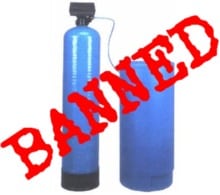 Water softening systems are another form of whole house water filter. They have been around for decades as a way to remove the hardness minerals calcium and magnesium from your water. Water Softening Systems take care of the calcium and magnesium by a method called ion exchange. A typical softener will have resin beads inside the main softening tank that will attract the hardness minerals. Once the resin beads are saturated with the minerals they need to be flushed away by a process called regeneration. That is why most softeners use salt.
Water softening systems are another form of whole house water filter. They have been around for decades as a way to remove the hardness minerals calcium and magnesium from your water. Water Softening Systems take care of the calcium and magnesium by a method called ion exchange. A typical softener will have resin beads inside the main softening tank that will attract the hardness minerals. Once the resin beads are saturated with the minerals they need to be flushed away by a process called regeneration. That is why most softeners use salt.
With typical Water Softening Systems you will have a brine tank that will hold the salt. When regeneration needs to occur the resin beads holding the hardness minerals will be flushed with the brine solution and the calcium and magnesium will be replaced and washed away by the salt solution. Some water softeners do this with a mechanical timer that is set to automatically regenerate the softener once or twice a week. How often you set it to regenerate will depend on the size of your family.
The more sophisticated Water Softening Systems will use a computerized timer that is simple to program. You put in information like how many people are in your household; the grains of hardness in your water, and what time you want it to regenerate. It will automatically program when the water softener regenerates based on the information you’ve programmed in.
Water Softening Systems… are they worth their weight in salt?
Now that you understand how water softening systems work let’s take a look at what they do to the enviroment. The amount of salt that is discharged from water softening systems is considered toxic waste that cannot be taken care of by local water municipalities. It is so toxic that states are now banning the use of water softening systems.
You should also not drink water that comes from water softening systems because of the high sodium content. You would need to use a desalinating filter such as a reverse osmosis system to remove the excessive salt. With the reverse osmosis system you run into the problem of having acidic water. This acidic water will actually cause important minerals such as calcium to be leached from your body.
There is a far better way to take care of the hard water problem without using salt. The Aquasana Rhino Whole House Water Filter will give you the impression of soft water (but does not reduce hardness) without taking out the natural trace minerals or adding sodium back into the water. Also by adding a .35 micron post filter you will help reduce hardness levels while keeping the mineral content of your water balanced out without adding sodium.
The first stage of the Aquasana Rhino whole house water filtration system uses a 5 micron pre-filter designed to remove things like dirt sediment and debris up to 4 times smaller than the eye can see. In the second stage of the Rhino we use a media called KDF-55 which removes chlorine from the water, and also controls scaling in your plumbing and fixtures. There is an oxidation charge that happens as the water passes the KDF media changing the structure of the calcium into aragonite (basically changing calcium from a brick shape into a triangular shape) and preventing the calcium from sticking together.
This same media also removes heavy metals like lead, nickel, chromium, and mercury up to 99.99%. After these two stages of filtration, the water passes through a coconut shell carbon which reduces synthetic chemicals like VOC’s, SOC’s, pharmaceuticals, trihalomethane’s, etc…. to the highest levels possible leaving you with clean and healthy water.




